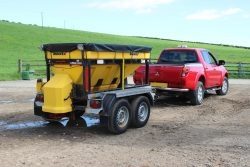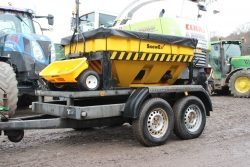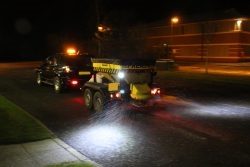Our Solution
How do we decide when to grit?
Deciding when we grit.
We employ a variety of sources to monitor weather conditions and forecasts. Road surface temperatures, which can be up to six degrees colder than air temperature, are key to our decision to start operations. Also important are predicted temperatures for the area involved. Site specific forecasts by the Met Office and New Weather for each site are received before midday for the coming evening. They are extremely detailed, providing an accurate 24 hour prediction of both the expected weather and road conditions. A copy can be passed on to clients who would like to study them. The decision on whether to grit is usually made by mid-afternoon.
Starting to grit.
Precautionary salting. Ideally salt should be spread before ice starts forming or snow starts falling and we do this when the forecast is for sub-zero temperatures. Prevention is better than cure, say so preventing ice forming is far better practice than treating roads already affected by frost or snow. Under normal circumstances, proactive gritting takes place between 1800 hours and 0600 hours, when there is limited vehicle and pedestrian activity, however, we are always on call and supply every customer with 24/7 emergency numbers to ensure our teams are always able to be contacted. Our vehicle fleet is fitted with GPRS Tracker units, enabling us to accurately monitor their position, ensuring a safe service and producing records of gritting for our clients.
How much salt do we use?
No less than 25 grams per square metre for precautionary salting and 40-100gms per square metre during ice and snow conditions. However, every situation is individually evaluated.
How does the salt work?
Salt works by lowering the freezing point of moisture on the surface. It can stop ice forming and cause existing ice or snow to melt. However, salt doesn’t work instantly; it needs to be ground down by pedestrian / vehicular traffic to be activated. It is worth noting this process will take far longer on pedestrian areas than on roads, which is why we endeavor to help the process by using specialist hand tools and spreaders. When the surfaces are dry there may be a white appearance caused by the salt, this will soon disappear. Any residual salt will itself attract moisture and can give the surface a damp appearance, this again is perfectly normal and the salt should prevent the moisture from freezing.
After gritting will our surfaces be 100% safe?
Unfortunately, there is no such thing as an absolutely safe surface, although we do our absolute best to minimize the risk!
Record keeping
We retain the forecast and vehicle tracker movement information for each day in the event there are any customer queries. At the completion of each job, the vehicle operator completes a job sheet, a copy of which can be left on site or forwarded later to the customer.
Snow Clearing
Clients can either opt for proactive or reactive snow clearing. Proactive clearing means we arrive before, during or just after the snow fall. With reactive it is the clients responsibility to request our attendance.
How do we clear snow?
Snow fall < 2.5cm Our principal practice is to re-grit at a high application rate. We clear pavements and walkways whilst applying salt to the pedestrian areas, for vehicular areas, we apply a high rate of salt and let vehicle tyres clear the snow. Snowfall > 2.5 cm mechanical clearing using tractor mounted snow ploughs or, smaller areas e.g. pavements, ATV mounted snow ploughs, shovels and scrapers. Once snow is clear we grit again. We have 3 tractor snow plough blades each fitted with rubbers and castors, one Vee plough for single track roads with deep snow and ATV mounted ploughs for smaller areas. Additionally, Skid steer loaders and telehandlers are available should they be required.


